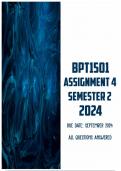Exam (elaborations)
BPT1501 Assignment 4 Semester 2 2024 | Due September 2024
- Institution
- University Of South Africa (Unisa)
- Book
- Becoming a Teacher
BPT1501 Assignment 4 Semester 2 2024 | Due September 2024. All questions answered. Read the following scenario before answer the question. Ms. Johnson is a Grade 7 teacher at Sunshine Primary School, located in a diverse community. Her classroom includes students from various backgrounds, with...
[Show more]




